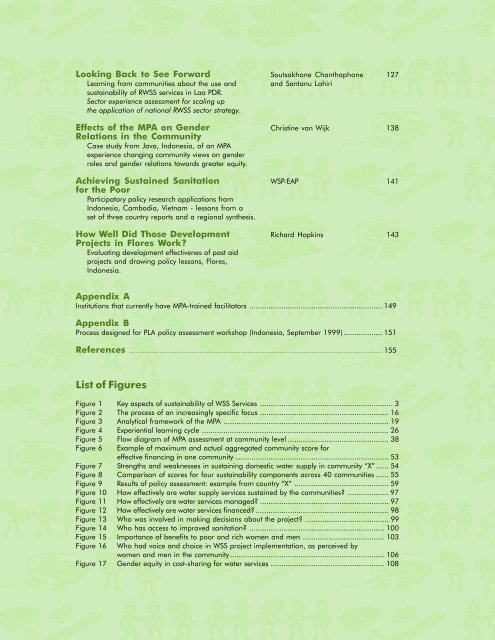Sustainability Planning and Monitoring
Sustainability Planning and Monitoring
Sustainability Planning and Monitoring
- No tags were found...
You also want an ePaper? Increase the reach of your titles
YUMPU automatically turns print PDFs into web optimized ePapers that Google loves.
Looking Back to See Forward Soutsakhone Chanthaphone 127Learning from communities about the use <strong>and</strong> <strong>and</strong> Santanu Lahirisustainability of RWSS services in Lao PDR.Sector experience assessment for scaling upthe application of national RWSS sector strategy.Effects of the MPA on Gender Christine van Wijk 138Relations in the CommunityCase study from Java, Indonesia, of an MPAexperience changing community views on genderroles <strong>and</strong> gender relations towards greater equity.Achieving Sustained Sanitation WSP-EAP 141for the PoorParticipatory policy research applications fromIndonesia, Cambodia, Vietnam - lessons from aset of three country reports <strong>and</strong> a regional synthesis.How Well Did Those Development Richard Hopkins 143Projects in Flores Work?Evaluating development effectivenes of past aidprojects <strong>and</strong> drawing policy lessons, Flores,Indonesia.Appendix AInstitutions that currently have MPA-trained facilitators .............................................................. 149Appendix BProcess designed for PLA policy assessment workshop (Indonesia, September 1999) .................. 151References ...................................................................................................................... 155List of FiguresFigure 1 Key aspects of sustainability of WSS Services .............................................................. 3Figure 2 The process of an increasingly specific focus ............................................................ 16Figure 3 Analytical framework of the MPA ............................................................................. 19Figure 4 Experiential learning cycle ....................................................................................... 26Figure 5 Flow diagram of MPA assessment at community level ............................................... 38Figure 6Example of maximum <strong>and</strong> actual aggregated community score foreffective financing in one community........................................................................ 53Figure 7 Strengths <strong>and</strong> weaknesses in sustaining domestic water supply in community “X” ...... 54Figure 8 Comparison of scores for four sustainability components across 40 communities ...... 55Figure 9 Results of policy assessment: example from country “X” ............................................ 59Figure 10 How effectively are water supply services sustained by the communities? ................... 97Figure 11 How effectively are water services managed? ............................................................ 97Figure 12 How effectively are water services financed? .............................................................. 98Figure 13 Who was involved in making decisions about the project? ....................................... 99Figure 14 Who has access to improved sanitation? ............................................................... 100Figure 15 Importance of benefits to poor <strong>and</strong> rich women <strong>and</strong> men ...................................... 103Figure 16 Who had voice <strong>and</strong> choice in WSS project implementation, as perceived bywomen <strong>and</strong> men in the community........................................................................ 106Figure 17 Gender equity in cost-sharing for water services ..................................................... 108
















